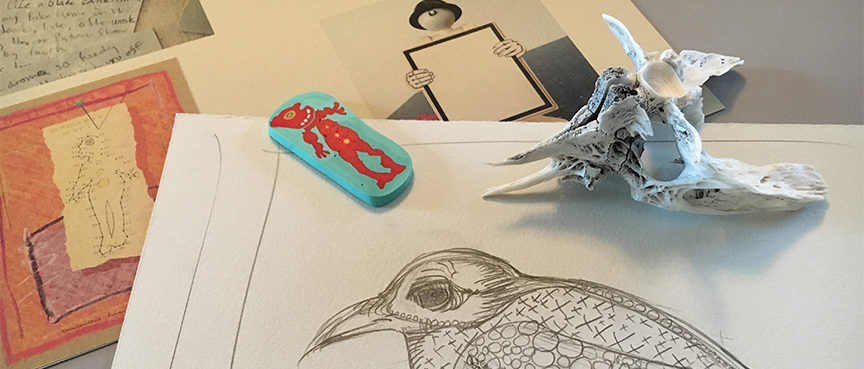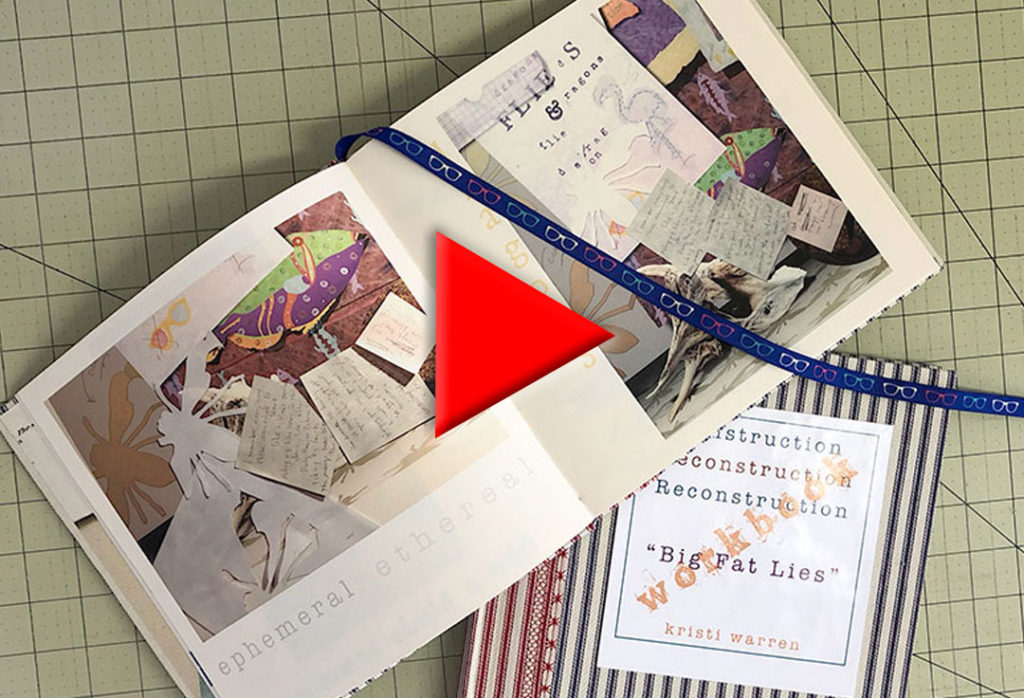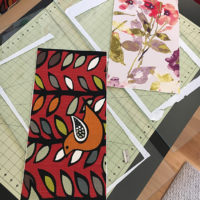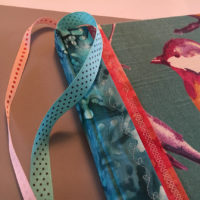A case-bound book is your most typical kind of book. The hardcover books on your bookshelves are probably all case-bound.
There are two main tasks to creating a case-bound book – creating the cover and creating the textblock. These are then joined together with the use of endpapers.
You’ll want to start by constructing the textblock . You’ll need to know the width of the finished textblock to know how wide the spine bookboard will need to be cut.
Once you have your signatures together you’ll want to mark and pre-punch them. I always create a template for this, particularly if I intend to make more than one of the books I’m constructing.
Jog all of your signatures together and place them on the table with the template on top, if you’re using one, and weight everything down so nothing moves around. It’s not necessary to raise them up as I’ve done here – I’m just doing this for the sake of the video to make it easier to see what I’m doing.
Use something stiff, like a piece of bookboard, to mark against. Drag your pencil up along the bookboard, making sure that each signature gets a tick mark at that point. Continue along in this fashion for each mark where you will make a hole to sew through.
You’ll want to make one extra mark on just one side of the signatures. This will only be used as a reference mark and you won’t be punching holes through these marks on each signature.
The purpose of this mark is to keep your signatures correctly aligned. It is very easy to get turned around as you are sewing because you will be moving the textblock around, but you want to keep each signature correctly aligned with the others, and this reference mark will help you do that. You can also just mark each signature with a post-it if you’d rather.
Next you will pre-punch the holes using a sewing needle. To make the needle easier to use you can give it a temporary handle by shoving the eye of the needle into a cork. This gives you something to hang on to.
Jog all of the pages in the signature together and hold them tightly as you poke a hole through each of the marks you’ve made.
Keep your needle as perpendicular to the pages as possible. You want the hole to be in the same position in each piece of paper in the signature so that they aren’t skewed once you start sewing them together. Do this to all of the signatures and maintain the orientation as you finish each one.
Remember that you don’t want to put a hole in the reference mark.
Next you want to prepare the thread. A good rule of thumb is to start with the length of the book times the number of signatures you have, plus extra for the tails at the beginning and the end. You can always add thread later if this isn’t enough, but this general measurement usually works. You’ll probably want to run the thread through your fingers a couple of times to relax the tension so it doesn’t tangle while you’re sewing.
you’ll probably want to run the thread through your fingers a couple of times to relax the tension
Finally you can start sewing. Start from the outside of one signature and push the needle into the center of the signature. Pull the thread through leaving at least a three-inch tail behind. Don’t knot this.
Sew out through the next hole. You don’t need to pull the thread tight yet, but pull some of the thread through. As you do this, always keep the thread parallel to the spine. If you pull perpendicular to the spine – out and away from the spine – you risk tearing the pages.
Go back in through the next hole and out through the next. Continue this process – in and out through the holes that you’ve marked and pre-punched. When you get to the last hole you should be on the outside of the signature. At this point you will want to tighten the stitches. Make sure you have left a reasonable tail behind – at least two to three inches.
Throughout this whole process as you sew each signature you always want your stitches to be taut, but not overly tight.
Grab the next signature and align the reference point with the first signature. Sew from the outside into the center of the second signature, back out through the next hole, back in, back out, until you reach the end.
You should be back on the outside of the signatures at this point, on the same end of the spine where you first started. Make sure that all of the stitches are taut and remember to pull your thread parallel to the spine to keep from ripping the paper. Now tie the thread and the loose tail together into a simple square knot. Make this knot tight but not overly so.
You can trim the tail now. This will later be glued to the spine. Align the next signature and begin this process again, sewing in and out of the holes that you’ve pre-punched. Once you reach the end of the signature, with the thread on the outside of the spine, you will make a new stitch called a kettle stich to join this signature to the rest of the signatures. Snug up your stitches.
To create the kettle stitch, pass the needle under the stitch in the first two signatures bringing the needle between the two signatures from the inside of the signature to the outside. Then bring the needle back up through the loop that is created in the thread. Pull this taut, holding the signatures together tightly as you do this.
Continue this process with the rest of the signatures, linking each new one to the others by using the kettle stich at the end of each one until you get to the last signature.
For the last signature create a normal kettle stitch between the previous two signatures then create a second kettle stitch between the last signature you just added and the previous one. This double kettle stitch will finish off the sewing and you can trim the thread.
Next you’ll want to glue the spine. Weight or clamp the textblock so that the signatures can’t move around or shift. If you don’t have a book press you can use a fabric-covered brick or some heavy books as a weight. You can even clothespin them together for this step.
Using the tip of your finger apply a coat of PVA glue along the entire spine, covering the thread and making sure that the glue is filling in between the grooves of the signatures, but make sure the signatures are firmly pressed together while doing this. You don’t want glue to be pushed way inside the grooves between the signatures. This will glue the edges of the pages together. You just want the glue on the outside along the edges. Wipe off any excess that gets over the edges. At this point you can fold the thread ends into the grooves between the signatures and glue those in place as well.
Leave the book weighted or clamped until the glue is completely dry. One of the advantages of using PVA glue, in addition to the fact that it’s Ph neutral is that it will remain flexible once it’s dried. This is important as it allows the book to open without cracking the spine.
Keep this weighted until it is completely dry, preferably overnight.
The next steps include adding the endpapers, mull to strengthen the spine, head and tail bands to hide the spine and add a bit of decoration, a ribbon bookmark and a piece of rice paper to finish it all off. Technically you could skip all of these items except the endpapers, and I suppose you could even skip those if you wanted to just glue the first and last pages of the book to the covers.
First you’ll want to chose your endpapers and cut them to size. Make them exactly the same height as your textblock and twice as wide. Fold them in half with the decorative side inside, if they have a decorative side.
Next you’ll glue these endpapers to the textblock. You only want to apply glue to a small portion of the folded edge, about one quarter to one half inch along the edge. Apply the glue on a piece of scrap paper and use another straight piece of scrap paper as a glue barrier .
Carefully attach these to each side of the textblock. If the decorative portion has an obvious orientation, be aware of this as you place these endpapers. Once you have glued both endpapers, put the textblock under weight to allow it to dry as you prepare for the next steps.
The next step is to add some reinforcement to the spine. This is done with a material that has several names – in the bookbinding world it is called mull or Super. You can also use cheesecloth, which is available at any supermarket or drugstore. It is just a coarse weave material that helps to reinforce the strength of the spine and also attaches the textblock to the cover, whatever that cover might be.
Cut the mull so that it is not quite as tall as the textblock and so that it wraps around the spine about 1 to 1 ½ inch on each side.
Apply glue to the spine to attach the mull. One of the advantages of using PVA glue, besides the fact that it is PH neutral, is that it remains flexible once it dries. This is an important factor when it comes to opening and closing your book.
Press the mull into the glue. You can even apply more glue after the fact, if you need to be sure it is adhering. You can do this with a brush or just with your fingertip dabbed in glue. The mull should not be glued to the endpapers yet, so be careful that you are attaching the mull only to the spine. I usually put this under weight temporarily as I work on the next pieces.
The next couple of steps will show you how to add some decorative elements. We’ll add a headband and tailband, and also a ribbon bookmark. None of these are important to the structure of the textblock and you can skip these steps if you want.
The material that I am using for the head and tailband is specialty material for exactly this purpose and can be purchase at any bookbinding store, such as Hollanders. You can also make a simpler version by wrapping and gluing fabric or paper around simple cord.
As a last element I’ll add a piece of rice paper to the spine. This doesn’t really add anything structurally but does help to cover up all of the various elements that are part of the spine, including the edges of the signatures, the thread, the mull, the ribbon bookmark and the headbands.
Measure and cut the amount of headband material needed for the top and bottom of the spine. Apply glue to the spine with a brush or with your finger and glue these pieces of headband in place.
Add a bit more glue to the piece of headband you just added and then glue the bookmark to the spine. You only need to glue an inch or two to the spine to give it a solid attachment point. If your textblock happens to have a particular orientation, which would be the case if you are constructing it from pages that you have already printed, then be sure you are gluing your bookmark so that it comes up and out the top of the book.
As the final step for your textblock, you’ll glue a piece of rice paper, or other lightweight paper, over the spine as a liner, covering the bookmark and head and tailbands.
Place another layer of glue over the ribbon that you just added and the tailband, as well as the rest of the length of the spine
Attach the paper, press this down and let it dry. Once it is dry and firmly attached tear or cut off the extra paper on each side of the spine. This doesn’t have to be done particularly carefully as the edges of this paper will never be seen.
This completes the textblock. Next you can start on the construction of the cover.



